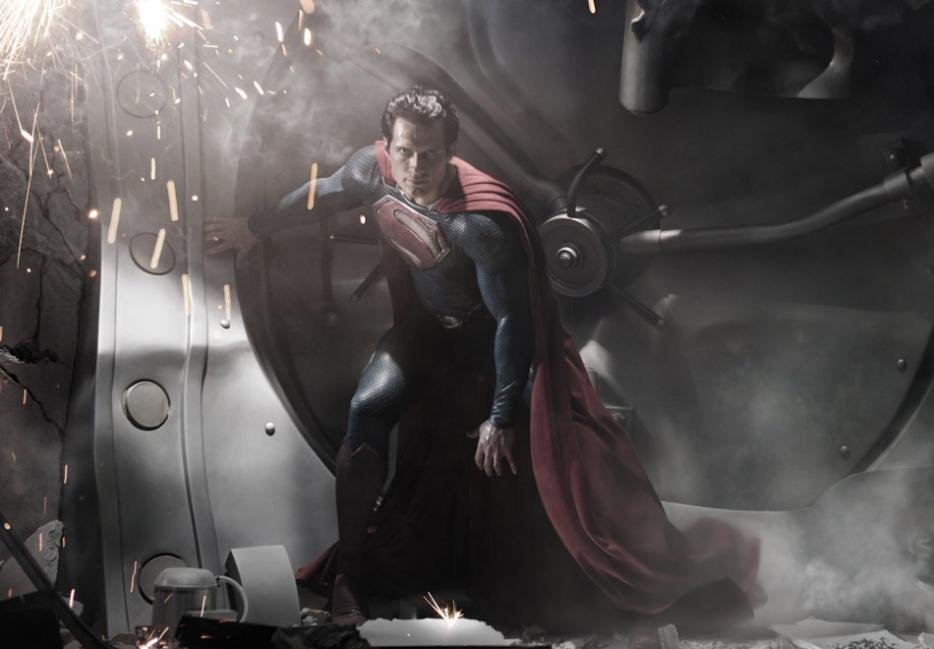“But he was just getting warmed up. Almost flying wasn’t good enough, not any more. Balling his fists, he threw his arms out in front of him and launched himself up, up, and away—in to the open air.”
It’s this small moment in the rigorously faithful novelization of Man of Steel (2013)—a callback to Superman’s famous catchphrase of yore, “up, up, and away”—where author Greg Cox makes his presence known. “I am still enough of a fanboy that it’s, ‘Oh my god, I’m going to do Godzilla! Oh my god, I’m getting to do Superman!,’” says Cox by phone from his home in Pennsylvania. When writing a novelization, his responsibility is to the studio’s licensing department, but “if you’re doing these iconic characters, if you’re doing a new version, you want to try to acknowledge the history without perhaps going overboard.”
With Man of Steel, The Dark Knight Rises, and Underworld to his credit, Cox is one of the top practitioners of the movie novelization. A prolific writer of sci-fi and horror stories since the 1980s, he made his name in the ’90s writing freelance stories based on popular franchise heroes—Batman, Iron Man, Star Trek, and others. This led to a job at Tor Books, where he edited many novelizations before he was commissioned to write one of his own, based on the Ben Affleck vehicle Daredevil (2003). He developed a reputation for dependability, and now he schedules his autumn months in anticipation of summer blockbuster season.
Last month he was putting the finishing touches on Godzilla, which trudges from Tokyo Bay into North American cinemas on May 15. He won’t see it until then.“This always tends to shock people, but I do not see the movie before it opens,” he says. “I am basically writing a 300-page description of a movie I have not seen yet.” The book arrives on May 20; Cox wrote the first draft in about 40 days.
He explains:
[I worked from] the screenplay and whatever visual reference is available and they can provide me. And whatever information I can perhaps extract from them through conversation—there are back-and-forth and emails and phone calls. I try to embellish as much as I can, and I am constantly desperate for anything they can send me in terms of visuals. I may get preproduction paintings, and handful of still photos. I was going through the trailer for Godzilla the other night frame-by-frame. …
The challenge is, you’re trying to turn a 110-page script into a 300-page novel, so you’ve got to flesh things out, especially since the script is just dialogue and action. If the script has just one line, ‘And there is an amazing car chase’... well, great, okay. The scriptwriter is leaving it to the stunt people or the fight choreographers to work it all out, but I’ve got to get a chapter out of that.
As you work, sometimes there are last-minute revisions. You get a phone call like, ‘Hi, they’ve shot a new scene, we’re faxing you new script pages,’ ‘They’ve reshot the ending, here’s the new ending.’ Godzilla’s only four months away, so I would hope it’s nearing the end, but I may well get a call saying, ‘Quick, we need you to add this new scene, write it this weekend, and get it to us on Monday,’ which has been known to happen.
To many, “the leading practitioner of movie novelizations” is a dubious distinction. In “This Nib for Hire,” a 2007 story by Woody Allen, a high-minded author named “Flanders Mealworm” is hired by a studio executive named “E. Coli Biggs” to write a novelization of a Three Stooges movie. “You know what a novelization is?” Biggs asks Mealworm. “It’s when a movie does good numbers. The producer hires some zombie to make a book out of it. Y’know, an exploitation paperback—strictly for lowbrows.” When Flanders dismisses the work as beneath him, Biggs replies, “Sure, sure, meanwhile every Shakespeare’s gotta eat lest he croak ere he mints his magnum opus.”
Out of the inky blackness, a shadowy shape roared past at high speed. An ebony cape flapped behind it.
Kelly’s jaw dropped.
“It can’t be…”
“What the hell was that?” Jansen exclaimed. He had no idea was was happening.
“Oh, boy,” the veteran cop said. “You’re in for a show tonight.”
- The Dark Knight Rises, a novel by Greg Cox
*
The first novelization is generally accepted to be 1912’s What Happened to Mary: A Novelization from the Play and the Stories Appearing in Ladies Home Journal, based on a cliffhanger serial. In his essay “Pulp Fiction: In Appreciation of Movie Novelizations,” Grady Hendrix cites 1933’s King Kong (Merian C. Cooper, Delos W. Lovelace) as the first major hit. Genres with obsessive collectors—i.e. sci-fi, children’s movies and horror—have always been the form’s bread and butter, but at the height of its popularity in the ’60s and ’70s, unlikely titles like Taxi Driver, California Split, Revenge of the Pink Panther, Young Frankenstein, Nosferatu the Vampyre, and Deep Throat were translated to the page.
Howard was short and slight, with comical, black-rimmed glasses and a fly-collar shirt buttoned at the throat. His dark, unruly hair fell low on his forehead, and there was a mischievous quality in his eyes. Although in his mid-thirties, Howard was still uncomplicated and boyish.
- The Front, a novel by Robert Alley
Picture Linda Lovelace: just the sound of her name, Love-lace. Love. Lace. Panties. Close your eyes and hear he name; roll it around on your tongue, savoring it. Linda. In Spanish, beautiful. And love? A special kind of sweetness mixed with heat. Picture this woman, then: Linda Lovelace. Her name sticks somewhere on your tastebuds.
- Deep Throat, a novel by D.M. Perkins
When these books were written, it was hard to see a movie outside its theatrical run or a one-off TV airing. With the advent of home video, the market for novelizations has eroded, but big-budget sci-fi and children’s movies still regularly receive mass-market paperback spinoffs. Commissioned and supervised by licensing departments and published by major houses, the books are seldom reviewed and typically fall out of print within a year, but when anticipation for a movie is high, they bring a tidy profit. The Dark Knight Rises was enough of a cultural juggernaut to make the New York Times bestseller list.
As a child, I was drawn to novelizations for their comforting familiarity (a well-known story is easier for a beginner reader to navigate), but also for how they could expand the universe of a film. It was surprising, for instance, to discover 40 pages on Batman and Two-Face’s origins in Peter David’s Batman Forever, or a new subplot in Max Allan Collins’ Dick Tracy about “Vitamin Flintheart,” an effete Shakespearean actor who helps Tracy crack the case. Hank Searls’ adaptation of the much-despised Jaws: The Revenge has gained a minor cult following for its outlandish departures from the script (it turns out a witch doctor put a curse on the Brody family, hence Jaws’ return); and Simon Hawke’s Friday the 13th Part III has a different ending than the film.
According to a 2012 article in the Houston Press, “When you want a science fiction movie adapted into a novel that might be better than the original source material, you don’t fuck around. You speed dial Alan Dean Foster and send the check pronto.” The opening scene of his novelization of Alien depicts the crew members in “hypersleep” on the way to Earth. Foster takes the opportunity to describe their dreams and flesh out their backstories—when they finally wake, the reader has more background on them than the film could provide. Embellishments like this have made Alien and its sequel among the few novelizations that have been consistently in print (a reissue from Titan Books is coming next month).
Foster has written dozens of science fiction novels and hundreds of stories of his own. He had several original novels to his credit in 1974 when Judy-Lynn Del Ray, his editor at Ballantine Books, commissioned a novelization of Luana, an Italian film about a female Tarzan, on the basis of his film degree from UCLA. “Being a young, eager writer [I] said, ‘Sure,’ without knowing what I was going into. I said, ‘Send me the script, I’ll work from the script.’ She said, ‘There is no script, but we’ll arrange a screening of the film for you in Los Angeles.’ So I went to this little dinky walk-up office on the third, fourth floor, someplace off Hollywood Boulevard. And they screened it for me and it was all in Italian with no subtitles. That wasn’t terribly helpful because I spoke no Italian.” The artist Frank Frazetta had been commissioned to paint promotional posters for the film, none of which bore much relation to the film itself. “So I novelized a Frank Rosetta painting, essentially,” Foster continues, and wrote his own female Tarzan book. A Disney representative called his publisher to see if the film rights were available.
Adaptations of Star Trek: The Animated Series and John Carpenter’s Dark Star led to steady work, and nowadayshis credits are a roll call of popular sci-fi: Star Wars (ghostwriting for George Lucas), Star Trek: The Motion Picture, Alien and Aliens, Clash of the Titans, The Thing, The Last Starfighter, Starman, Terminator Salvation, Star Trek Into Darkness, and the Transformers series (including a 2009 spin-off novel, Transformers: The Veiled Threat). He makes no bones about seeking a paycheck, but he also defends the form.
It doesn’t make any sense to me why somebody should take a book like Ben-Hur, write a screenplay based on it, and get Academy Awards and have it touted as a terrific piece of writing, when the reverse is considered hackwork. Having done a lot of both, I can say this: It’s much easier to extract a screenplay from a book, because you have far more material, than it is to take a screenplay and make a book out of it, because you have to add a lot of stuff. If it’s a good job.
*
Over the years, though, Foster says that studios have held a tighter grip on the creative process: Star Wars and its progeny made tie-in merchandise nearly as lucrative as the movie. “You can blame George Lucas—or Walt Disney, if you want to go back—but particularly George,” Foster says. It seems counterintuitive: If you love the movie enough to read the novelization, wouldn’t you want to learn more about the world? “That’s half the point of doing a novelization in the first place,” he says. “If you’re just going to transcribe from script form into prose form, any competent high school English major can do that, and it’s a cheat. Why not just publish the screenplay and let people buy that?”
While Foster’s Alien and Aliens are often cited among the best of their kind, he didn’t have as much freedom when the third movie came along.
The most notorious example that I’ve been involved with is Alien 3, which I thought was a very poor script, the one that finally showed up. I can’t really blame David Fincher for that—or maybe you can, partly, but maybe blame everybody involved.
I had done Alien and Aliens and was very proud of both—although Warner bowdlerized Aliens and took out all the cuss words. That kind of gobsmacked me, because fans read the book and said, ‘Y’know, you’ve got your space marines talking like junior high school kids,’ and I said, ‘What?’ But aside from that, with Alien 3 I thought, well, I’ll do my usual thing: I’ll try to fix what I can without radically changing the plot or the characters or anything else.
I did a lot of work on that—I’m sure you remember the film, whether you want to or not. All of those guys on that prison planet must have had a reason for being there, so in the course of writing the book, I gave them all backstories explaining why they’re there, trying to make them into real characters instead of just alien chow. And I vociferously disagreed with killing Newt, the little girl at the beginning, because not only is that kind of an obscene thing to do in a film, but taking her life takes away Ripley’s reason for fighting for her continued existence. So I thought it was a terrible piece of plotting. Little things like that.
So I put a lot of work into the book and then got a letter from Walter Hill, who was one of the producers, saying, ‘You can’t do this, you have to follow the script exactly the way it’s written, we think it will make a better book.’ And I didn’t write back, ‘I’ve done this kind of thing before, I know what I’m doing.’ Because in a work-for-hire you can’t do that.
One of the great bylines I’ve come across is for the novelization of Mary Shelley’s Frankenstein (1994), which credits “A Novel by Leonore Fleischer, based on the Screenplay by Steph Lady and Frank Darabont, based on the novel by Mary Wollstonecraft Shelley.” Such a convoluted web of authorship raises the questions: Where, exactly, can the writer make his mark? Is it possible to feel close to characters one hasn’t created, in stories conceived by others?
“You can’t work with them for a certain amount of time and not feel possessive,” Foster says. “I’m always aware of the fact when I’m doing a novelization, or a book that is set in somebody else’s universe, that I am working with somebody else’s creations, and I try to be as true to that as I possibly can be. I view a novelization as a collaboration just as I would if I was writing an original novel with another writer down the street.
“A collaboration is a collaboration,” he adds, “and it’s not me taking somebody else’s work and making it my own—that would be aesthetically immoral.” For those of us who regard writing primarily as a means of self-expression, this would seem most unrewarding. But if a novelization is working, it’s from this sense of collaboration—with the filmmakers, with the screenwriters, with a character’s long history—that creative satisfaction has to derive.
The original article misidentified the Alien 3 producer who Alan Dean Foster corresponded with. His name was Walter Hill, not David Giler. Hazlitt regrets the error.






